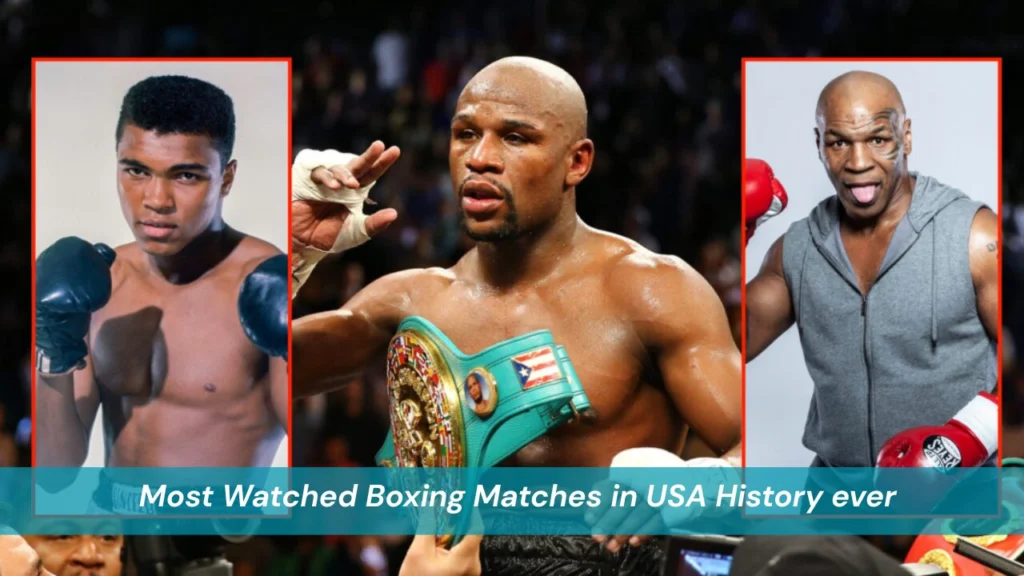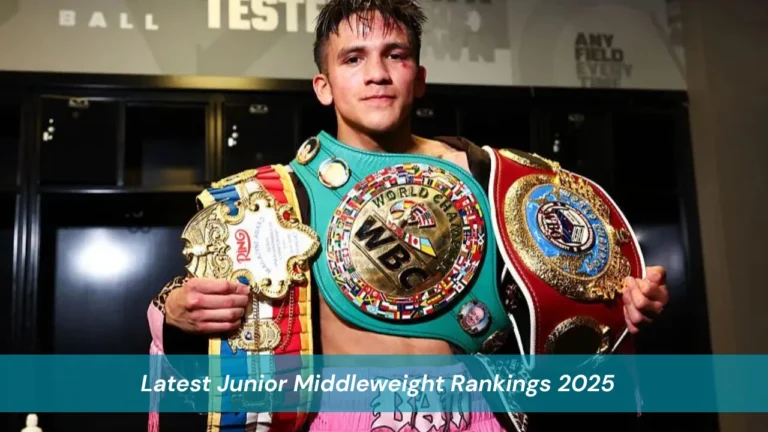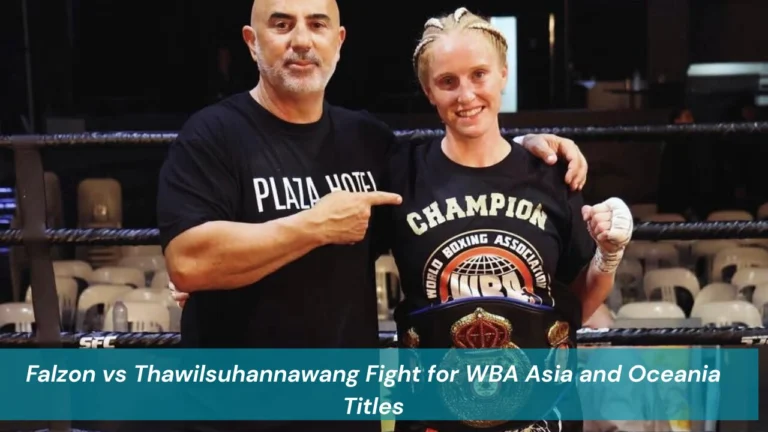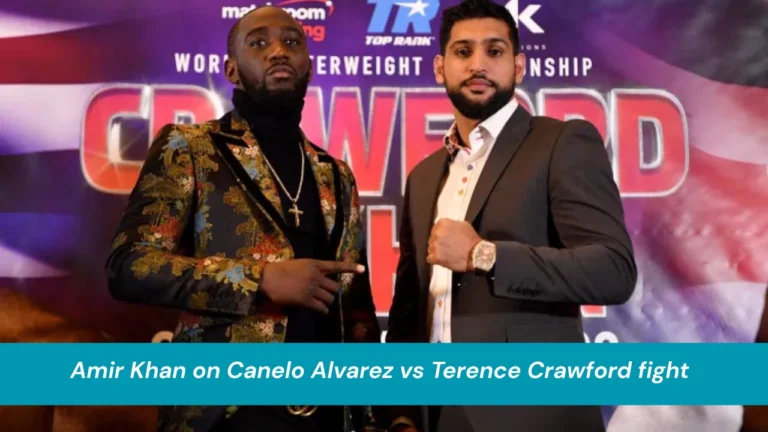Boxing has long held a unique place in American sports culture. Unlike most team sports, a great boxing match is two fighters, one ring, and millions of fans holding their breath. Over the decades, certain bouts have not only made history but also united the nation, drawing unprecedented numbers of viewers across platforms and generations.
In the digital age of fragmented attention, it’s almost hard to believe that one sporting event could pull tens of millions of people into a shared moment. Yet, that’s exactly what the most watched boxing matches in USA history have done. These weren’t just fights; they were national moments laced with hype, drama, and cultural significance.
Ali, Tyson, and Mayweather Titans of the Screen
When conversations turn to the biggest fights ever witnessed in the U.S., three names dominate like heavyweights in the ring: Muhammad Ali, Mike Tyson, and Floyd Mayweather Jr. Each of them represents a different era of boxing and brought with them unique charisma and appeal that pulled in viewers far beyond typical sports fans.
Ali wasn’t just a boxer; he was a symbol. His 1978 rematch with Leon Spinks, aired on ABC, pulled in an estimated 35 million viewers in the U.S. alone. That’s a staggering number, considering the population and the lack of modern marketing tools. The fight was a redemption story from the aging champion determined to reclaim his throne. It was televised across households that didn’t even watch boxing regularly, yet tuned in because it was Ali.
Tyson’s appeal was different. Where Ali used words, Tyson used brute force. In the late ’80s and early ’90s, Tyson was an unstoppable machine. His 1997 fight with Evander Holyfield yes, the infamous ear-biting episode drew nearly 2 million PPV buys, a figure that was mind-blowing at the time. It wasn’t just the boxing; it was the unpredictability that drew the nation in. People didn’t want to miss what Tyson might do next.
Then came Floyd Mayweather Jr., who took the PPV model and turned it into a science. His 2015 clash with Manny Pacquiao, known as the “Fight of the Century,” holds the record for the most watched PPV fight in U.S. history with 4.6 million domestic buys. The buildup lasted for years, creating a fever pitch of anticipation that paid off commercially even if the fight itself was more chess match than brawl.
Pay-Per-View’s Golden Era and the Power of Personality
The rise of pay-per-view redefined how Americans consumed boxing. In the 1970s, fans watched fights in packed theaters via closed-circuit TV. By the late ’80s, that model gave way to PPV at home, a game changer that allowed promoters to reach millions instantly, for a price.
But what made these events truly massive was the way they were packaged. Mayweather’s brilliance wasn’t just in his undefeated record; it was in creating a persona “Money Mayweather” that fans either loved or desperately wanted to see lose. In both cases, they tuned in. When he faced Conor McGregor in 2017, it wasn’t even a traditional boxing rivalry. Yet it became the second most watched boxing PPV in U.S. history with 4.3 million buys, driven largely by narrative and spectacle.
It’s worth noting that many of these record-setting bouts weren’t championship unifications. The belts mattered less than the storylines. Boxing fans tuned in not just for skills but for drama. The sport became a form of episodic entertainment, and the fighters love them or hate them were the stars of a global soap opera.
Boxing on Free TV When Everyone Watched Together
Before the dominance of cable and streaming, boxing thrived on free-to-air television. These were the days when entire families could gather in front of the living room TV without paying extra, and millions did just that.
Sugar Ray Leonard’s 1981 classic against Thomas Hearns was one of the last true broadcast blockbusters, attracting nearly 25 million U.S. viewers. It was a stylistic clash between Leonard’s speed and Hearns’ reach, packaged perfectly for a prime-time ABC audience. It wasn’t just a big fight, it was an event, complete with pre-fight specials and post-fight analysis that mimicked the coverage of presidential debates or the Super Bowl.
Ali’s era took it even further. While some of his most famous fights like the “Rumble in the Jungle” or “Thrilla in Manila” had international coverage and were watched live in theaters or on delay, the buzz in the U.S. was undeniable. People talked about the fights at work, in bars, and around the dinner table. They didn’t need Twitter or YouTube; they had watercoolers and radios.
Those days now feel like a different world, but they laid the groundwork for what boxing would become one of the few sports that could bring tens of millions of people together for a single night.
The Streaming Shift and the Viral Era of Boxing
The digital era brought new challenges and new opportunities for boxing. Traditional PPV still exists, but platforms like DAZN and ESPN+ have altered how fans access fights. Instead of a $100 price tag, fans now pay a monthly fee and get dozens of fights. On top of that, YouTube, Instagram, and TikTok now serve as promotional tools and recap platforms, sometimes reaching more people than the live event itself.
A perfect example of this shift was the Gervonta Davis vs. Ryan Garcia fight in 2023. While it sold over 1.2 million PPVs a remarkable number in a post-Mayweather era the real buzz was online. Highlight clips racked up millions of views within hours. Hashtags trended. Fan reactions were uploaded in real time. The fight became a full-on social media event, reflecting how younger fans consume and share content.
This isn’t to say traditional metrics are obsolete, but the definition of “most watched” has evolved. Engagement now includes live tweets, meme reactions, and YouTube rewatches. A single punch, shared at the right moment, can be seen by more people than the entire PPV audience.
What These Fights Reveal About American Culture
Boxing has always mirrored society. In the 1960s and 70s, Ali was more than a boxer he was a voice against war and racism. People tuned in not just for his fights, but for what he stood for. Tyson’s rise in the 80s reflected a culture obsessed with power and dominance. Mayweather’s success coincided with the rise of brand-building, self-promotion, and luxury culture.
The most watched fights are rarely just about athletics. They’re about identity, spectacle, and the emotional stakes tied to a win or loss. Whether it’s nationalism, underdog stories, or celebrity appeal, the motivations for tuning in run deeper than sport. Boxing, in this way, becomes a lens into what America is fascinated by at a given moment.
These events become shared experiences. They turn living rooms into arenas and transform fighters into cultural icons. That’s why millions still show up even if only virtually because when boxing is at its best, it’s not just a sport. It’s a moment.
The Numbers Behind the Hype Legacy in Viewership
Even though we now measure success with multiple metrics PPV buys, social impressions, YouTube views the weight of a fight is still often defined by how many people watched it live. Mayweather vs. Pacquiao remains the high-water mark in American PPV history, both in viewership and revenue.
Ali’s fights, while harder to quantify by modern standards, still hold symbolic importance. His ability to draw audiences with minimal technology is a testament to his cultural power. Tyson’s numbers exploded during a time when PPV was still maturing, setting the foundation for future stars.
Each generation of viewers left behind a different legacy. Older fans reminisce about watching Ali on network TV. Gen Xers recall the drama of Tyson-Holyfield. Millennials remember streaming Mayweather fights while tweeting in real time. Each moment added a new chapter to boxing’s viewership history.
Frequently Asked Questions
What is the most watched boxing match in U.S. history?
The 2015 fight between Floyd Mayweather and Manny Pacquiao holds the record with 4.6 million PPV buys in the United States alone, generating more than $410 million in domestic revenue.
Did any boxing match on free television reach massive audiences?
Yes, Muhammad Ali’s rematch against Leon Spinks in 1978 was broadcast on ABC and reached an estimated 35 million U.S. viewers, making it one of the most viewed sporting events on free-to-air TV.
How has streaming changed boxing viewership?
Streaming platforms like DAZN and ESPN+ have introduced subscription models that provide more access but lower per-event revenue. Viral clips and social media now play a major role in how fights are consumed and discussed.
What defines a highly watched boxing match today?
Today, it’s a combination of live viewership, online engagement, and media buzz. A fight might have fewer PPV buys but still dominate the cultural conversation through shares, memes, and trending hashtags.
Do exhibition or crossover fights count in viewership rankings?
Yes, as long as they follow boxing rules and draw massive attention. The Mayweather vs. McGregor bout in 2017 is a prime example, with 4.3 million domestic PPV buys, despite McGregor being an MMA fighter.
Conclusion
The most watched boxing matches in USA history tell more than just a story of punches and knockouts; they reflect how America sees its heroes, villains, and itself. These bouts didn’t just break records; they shaped culture. From Ali’s principled stands to Mayweather’s luxury branding, the ring has been a stage for more than just sport.
And as technology continues to evolve, boxing finds new ways to reach fans whether through streaming apps or viral TikToks. But one thing remains constant: when the stakes are high and the spotlight is bright, millions still tune in to witness greatness. For more stories that shaped boxing history, visit boxing essential to explore more.




